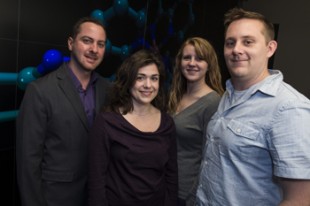Metallic probe proves able to detect fibrils from misfolded proteins in real time
Rice University scientists have discovered a new way to look inside living cells and see the insoluble fibrillar deposits associated with Parkinson’s disease.
The combined talents of two Rice laboratories – one that studies the misfolded proteins that cause neurodegenerative diseases and another that specializes in photoluminescent probes – led to the spectroscopic technique that could become a valuable tool for scientists and pharmaceutical companies.
The research by the Rice labs of Angel Martí and Laura Segatori appeared online today in the Journal of the American Chemical Society.
The researchers designed a molecular probe based on the metallic element ruthenium. Testing inside live neuroglioma cells, they found the probe binds with the misfolded alpha-synuclein proteins that clump together and form fibrils and disrupt the cell’s functions. The ruthenium complex lit up when triggered by a laser – but only when attached to the fibril, which allowed aggregation to be tracked using photoluminescence spectroscopy.

Fibrallar deposits associated with Parkinson's disease light up when combined with a ruthenium-based probe developed at Rice University. Image by Martí Group/Rice University
Researchers trying to understand molecular mechanisms of protein misfolding have had limited alternatives to monitor protein aggregation in cells, Martí said. A probe that can monitor the formation of aggregates should be of great value in the search for drugs that break up fibrils or prevent them from ever forming.
Two years ago, Martí, an assistant professor of chemistry and bioengineering, and Rice graduate student Nathan Cook revealed their metallic compounds that switch on like a light bulb when they attach to misfolded proteins; that study involved the beta amyloids that form plaques in the brains of Alzheimer’s sufferers.
At about the same time, Cook approached Segatori, the T.N. Law Assistant Professor of Chemical and Biomolecular Engineering and assistant professor of biochemistry and cell biology, to ask if she would serve on his dissertation committee. They started talking about his work with Martí, and Segatori quickly saw the potential of a partnership.
Segatori has made important strides in the study of diseases caused by proteins that misfold and clump together. Alzheimer’s, Parkinson’s and Gaucher diseases are examples, all the result of genetic mutations or conditions that disrupt the way proteins fold and keep them from performing their functions.

Two Rice labs combined to create a new method for looking at signs of Parkinson's disease inside cells. From left, professors Angel Martí and Laura Segatori and graduate students Kiri Kilpatrick and Nathan Cook. Photo by Jeff Fitlow
“There are a few compounds you can use to detect the presence of these types of protein aggregates, but none of them have been reported to work in cells,” Segatori said. “When you’re thinking about developing a therapeutic strategy, you want to be able to detect the presence of fibril aggregates in living cells, or even in animals. It’s been very nice to collaborate with someone with the expertise to do this.”
“The connection between Parkinson’s and Alzheimer’s is natural, although they are very different diseases because Alzheimer’s beta amyloid peptides are extracellular, while the onset of Parkinson’s is associated with alpha-synuclein protein inside cells,” Martí said. “We always thought we could apply the same techniques we used for beta amyloids to probe the aggregation of other proteins.
“When we learned that Laura has cells that overexpress alpha-synuclein, we thought, ‘That’s perfect.’ She had the system and we had the probes,” he said.
Segatori pointed out the ruthenium complex has no therapeutic benefit for Parkinson’s sufferers, but “is a step toward understanding the chemistry, which obviously will help in the development of drugs.”
They see the possibility that metallic complexes can be tailored to tag aggregates implicated in other degenerative diseases. “Metal complexes are like Legos, in the sense that you can attach whatever you want to them,” Cook said.
As a proof of principle, the researchers created an in vitro cell model of Parkinson’s disease and found their ruthenium complexes clearly labeled fibrillar alpha-synuclein proteins in cells.
“We can use it to test our strategies to prevent misfolding of proteins or to increase their degradation, so they will be eliminated,” Segatori said. “It will be an easy tool to use for a lot of experiments.”
Kiri Kilpatrick, a graduate student in Segatori’s lab, co-authored the paper.
The National Science Foundation and the Welch Foundation supported the research.


Leave a Reply